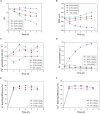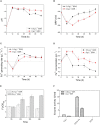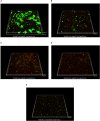Oxidative Stress Induced by Metal Ions in Bioleaching of LiCoO2 by an Acidophilic Microbial Consortium
- PMID: 32010108
- PMCID: PMC6974807
- DOI: 10.3389/fmicb.2019.03058
Oxidative Stress Induced by Metal Ions in Bioleaching of LiCoO2 by an Acidophilic Microbial Consortium
Abstract
An acidophilic microbial consortium (AMC) was used to investigate the fundamental mechanism behind the adverse effects of pulp density increase in the bioleaching of waste lithium ion batteries (WLIBs). Results showed that there existed the effect of metal-ion stress on the bio-oxidative activity of AMC. The Li+ and Co2+ accumulated in the leachate were the direct cause for the decrease in lithium and cobalt recovery yields under a high pulp density. In a simulated bioleaching system with 4.0% (w ⋅v-1) LiCoO2, the intracellular reactive oxygen species (ROS) content in AMC increased from 0.82 to 6.02 within 24 h, which was almost three times higher than that of the control (2.04). After the supplementation of 0.30 g⋅L-1 of exogenous glutathione (GSH), the bacterial intracellular ROS content decreased by 40% within 24 h and the activities of intracellular ROS scavenging enzymes, including glutathione peroxidase (GSH-Px) and catalase (CAT), were 1.4- and 2.0-folds higher in comparison with the control within 24 h. In the biofilms formed on pyrite in the bioleaching of WLIBs, it was found that metal-ion stress had a great influence on the 3-D structure and the amount of biomass of the biofilms. After the exogenous addition of GSH, the structure and the amount of biomass of the biofilms were restored to some extent. Eventually, through ROS regulation by the exogenous addition of GSH, very high metal recovery yields of 98.1% Li and 96.3% Co were obtained at 5.0% pulp density.
Keywords: ROS; acidophilic microbial consortium; biofilm; bioleaching; glutathion; waste lithium ion battery.
Copyright © 2020 Liu, Liu, Wu, Zhang, Gu, Zhu and Tan.
Figures









Similar articles
-
Strategies for anti-oxidative stress and anti-acid stress in bioleaching of LiCoO2 using an acidophilic microbial consortium.Extremophiles. 2022 Jun 29;26(2):22. doi: 10.1007/s00792-022-01270-3. Extremophiles. 2022. PMID: 35767155
-
Advances in bioleaching of waste lithium batteries under metal ion stress.Bioresour Bioprocess. 2023 Mar 10;10(1):19. doi: 10.1186/s40643-023-00636-5. Bioresour Bioprocess. 2023. PMID: 38647921 Free PMC article. Review.
-
Multi-scale analysis of acidophilic microbial consortium biofilm's tolerance of lithium and cobalt ions in bioleaching.J Hazard Mater. 2024 Aug 5;474:134764. doi: 10.1016/j.jhazmat.2024.134764. Epub 2024 May 29. J Hazard Mater. 2024. PMID: 38824773
-
Characteristics of oxidative stress and antioxidant defenses by a mixed culture of acidophilic bacteria in response to Co2+ exposure.Extremophiles. 2020 Jul;24(4):485-499. doi: 10.1007/s00792-020-01170-4. Epub 2020 Apr 22. Extremophiles. 2020. PMID: 32322992
-
Lithium bioleaching: An emerging approach for the recovery of Li from spent lithium ion batteries.Chemosphere. 2021 Aug;277:130196. doi: 10.1016/j.chemosphere.2021.130196. Epub 2021 Mar 6. Chemosphere. 2021. PMID: 33784558 Review.
Cited by
-
Recovery of valuable metals from spent lithium-ion batteries using microbial agents for bioleaching: a review.Front Microbiol. 2023 May 31;14:1197081. doi: 10.3389/fmicb.2023.1197081. eCollection 2023. Front Microbiol. 2023. PMID: 37323903 Free PMC article. Review.
-
A Critical Review on the Recovery of Base and Critical Elements from Electronic Waste-Contaminated Streams Using Microbial Biotechnology.Appl Biochem Biotechnol. 2023 Dec;195(12):7859-7888. doi: 10.1007/s12010-023-04440-x. Epub 2023 Mar 29. Appl Biochem Biotechnol. 2023. PMID: 36988841 Review.
-
Strategies for anti-oxidative stress and anti-acid stress in bioleaching of LiCoO2 using an acidophilic microbial consortium.Extremophiles. 2022 Jun 29;26(2):22. doi: 10.1007/s00792-022-01270-3. Extremophiles. 2022. PMID: 35767155
-
Advances in bioleaching of waste lithium batteries under metal ion stress.Bioresour Bioprocess. 2023 Mar 10;10(1):19. doi: 10.1186/s40643-023-00636-5. Bioresour Bioprocess. 2023. PMID: 38647921 Free PMC article. Review.
-
Highly Efficient Recovery and Recycling of Cobalt from Spent Lithium-Ion Batteries Using an N-Methylurea-Acetamide Nonionic Deep Eutectic Solvent.ACS Omega. 2023 Feb 13;8(7):6959-6967. doi: 10.1021/acsomega.2c07780. eCollection 2023 Feb 21. ACS Omega. 2023. PMID: 36844576 Free PMC article.
References
-
- Bajestani M. I., Mousavi S. M., Shojaosadati S. A. (2014). Bioleaching of heavy metals from spent household batteries using Acidithiobacillus ferrooxidans: statistical evaluation and optimization. Sep. Purif. Technol. 132 309–316. 10.1016/j.seppur.2014.05.023 - DOI
-
- Chen B. Y., Liu H. L., Chen Y. W., Cheng Y. C. (2004). Dose–response assessment of metal toxicity upon indigenous Thiobacillus thiooxidans BC1. Process Biochem. 39 737–748. 10.1016/s0032-9592(03)00180-8 - DOI
LinkOut - more resources
Full Text Sources
Miscellaneous

